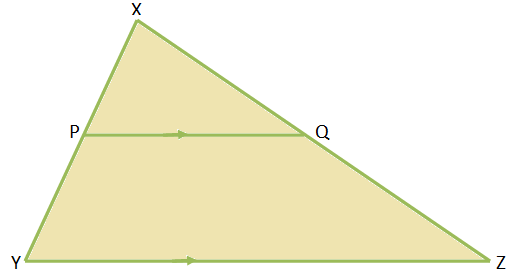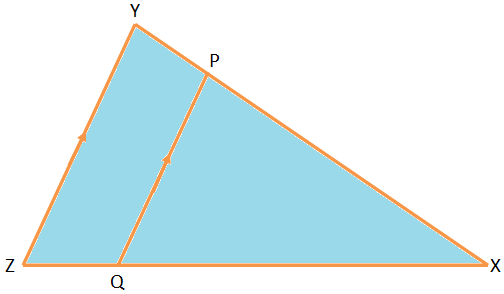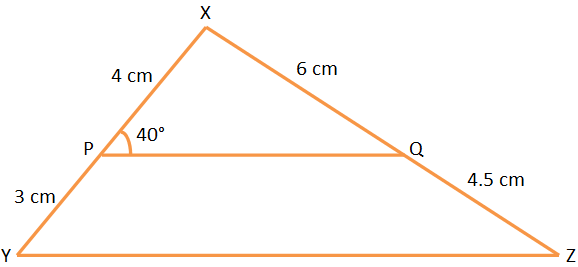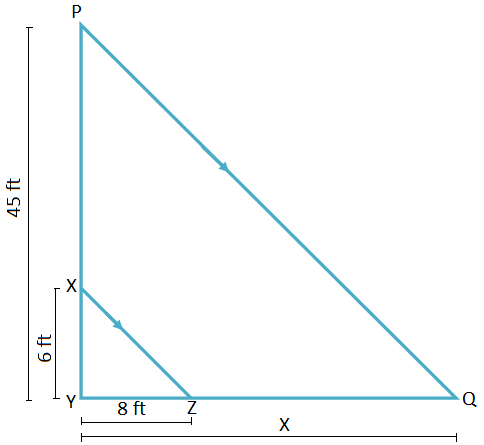Subscribe to our ▶️ YouTube channel 🔴 for the latest videos, updates, and tips.
Basic Proportionality Theorem
Here we will learn how to prove the basic proportionality theorem with diagram.
A line drawn parallel to one side of a triangle divides the other two sides proportionally.
Given: In ∆XYZ, P and Q are points on XY and XZ respectively, such that PQ ∥ YZ.
To prove: \(\frac{XP}{PY}\) = \(\frac{XQ}{QZ}\).
Proof:
|
Statement |
Reason |
|
1. In ∆XYZ and ∆XPQ, (i) ∠YXZ = ∠PXQ (ii) ∠XYZ = ∠XPQ |
1. (i) Common angle (ii) Corresponding angles |
|
2. ∆XYZ ∼ ∆XPQ |
2. AA criterion of similarity. |
|
3. \(\frac{XY}{XP}\) = \(\frac{XZ}{XQ}\) |
3. Corresponding sides of similar triangles are proportional. |
|
4. \(\frac{XY}{XP}\) – 1 = \(\frac{XZ}{XQ}\) – 1 ⟹ \(\frac{XY - XP}{XP}\) = \(\frac{XZ - XQ}{XQ}\) ⟹ \(\frac{PY}{XP}\) = \(\frac{QZ}{XQ}\) |
4. By subtracting 1 from both sides of statement 3. |
|
5. \(\frac{XP}{PY}\) = \(\frac{XQ}{QZ}\) |
5. Taking reciprocals of both sides in statement 4. |
Solved examples using basic proportionality theorem:
1. If in a ∆XYZ, P and Q are two points on XY and XZ respectively such that XP = 4 cm, PY = 3 cm, XQ = = 6 cm, QZ = 4.5 cm and ∠XPQ = 40° then find ∠XYZ.
Solution:
Here, \(\frac{XP}{PY}\) = \(\frac{4 cm}{3 cm}\) = \(\frac{4}{3}\), and
\(\frac{XQ}{QZ}\) = \(\frac{6 cm}{4.5 cm}\) = \(\frac{4}{3}\)
Therefore, \(\frac{XP}{PY}\) = \(\frac{XQ}{QZ}\)
⟹ PQ ∥ YZ
Therefore, ∠XYZ = ∠XPQ = 40°.
2. In the given figure, if XP = 6 cm, YP = 2 cm, XQ = 7.5 cm, find QZ.
Solution:
By basic proportionality theorem,
\(\frac{XP}{PY}\) = \(\frac{XQ}{QZ}\)
⟹ \(\frac{6 cm}{2 cm}\) = \(\frac{7.5 cm}{QZ}\)
⟹ QZ = \(\frac{7.5 cm × 2}{6}\)
⟹ QZ = 2.5 cm.
3. At a certain time of the day, a man, 6 feet tall, casts his shadow 8 feet long. Find the length of the shadow cast by a building 45 feet high, at the same time.
Solution:
Let the length of the shadow of the building be x.
As the source of light is the sun, XZ ∥ PQ and, hence ∆YXZ ∼ ∆YPQ.
Therefore, \(\frac{\textrm{Height of the Man}}{\textrm{Height of the Building}}\) = \(\frac{\textrm{Length of Shadow Cast by the Man}}{\textrm{Length of Shadow Cast by the Building}}\)
⟹ \(\frac{6 ft}{45 ft}\) = \(\frac{8 ft}{x}\)
⟹ x = 60 feet.
From Basic Proportionality Theorem to HOME PAGE
Didn't find what you were looking for? Or want to know more information about Math Only Math. Use this Google Search to find what you need.






New! Comments
Have your say about what you just read! Leave me a comment in the box below. Ask a Question or Answer a Question.